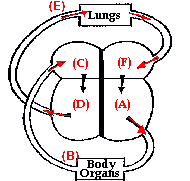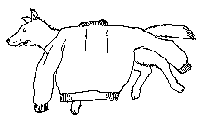Shock is a condition resulting from a depressed state of many vital body functions caused by a lack of effective circulation. A veterinary textbook on emergency medicine defines shock as “the clinical state resulting from an inadequate supply of oxygen to the tissues or an inability of the tissues to properly use oxygen.” The term ‘shock’ can mean different things to different people, and medical professionals still debate the true meaning of the word. Regardless of cause, shock is life-threatening and requires immediate attention and treatment. If signs of shock are recognized, or a serious injury has taken place, supportive care, such as intravenous (IV) fluids, oxygen and other measures can help reverse shock and prevent permanent organ damage. The key to successful overall treatment is prompt professional care.
Shock and the Cardiovascular System

To gain a basic understanding of shock, one must first have an understanding of the normal cardiovascular system of dogs and cats. Think of the cardiovascular system as a closed circuit consisting of a pump (the heart) and a series of stretchable tubes (blood vessels). The system is filled to capacity with a fluid (blood) that circulates through the tubes delivering fuel (oxygen and other metabolic substances) and picking up trash (carbon dioxide and other metabolic waste). In order to be efficient, the pump must be able to deliver a proper amount of the fluid and there must be enough fluid to completely fill and stretch the system of tubes. An insult to any part of this system that results in lower fuel delivery, excess fuel burning, and/or excess waste accumulation may result in shock and decreased oxygen delivery.
Causes of Shock
The most common cause of shock in our pets is trauma: e.g., fights with other animals, being hit by a car, and gunshots. Other causes include poisoning, insect stings, fluid loss from vomiting and/or diarrhea, infections, burns, and lack of oxygen caused by heart failure or obstruction of airways (pneumonia or choking, for example).
Basically, it can be broken down into:
- Cardiogenic shock
- Hemorrhagic or hypovolemic shock
- Anaphylactic shock
- Septic shock
Regardless of the cause, shock is life-threatening. Immediate identification and treatment is crucial.
Signs of Shock
Early Signs of Shock
- The pet may be either excited or subdued.
- Rapid heart rate.
- Pulse not difficult to find.
- Gums may be normal or pale
Late Signs of Shock
- Gums extremely pale or show a bluish discoloration.
- Heart rate is probably elevated and irregular, but may be normal or below normal as heart muscle begins to fail.
- The pulse will be weak and either difficult or impossible to locate.
- The pet will feel cold to the touch and rectal temperature will be below normal.
- Respiration may be slow or rapid, shallow or deep.
- The eyes may take on a glazed appearance and appear not to focus normally.
- Mental condition deteriorates from depression to stupor to coma.
What to Do

Successful treatment of a patient in shock involves prompt recognition of the signs, immediate initiation of first aid procedures, and safe and rapid transport to a veterinary facility for definitive treatment.
- Provide adequate breathing if needed (see CPR).
- Stop bleeding.
- Apply a muzzle, if pain or apprehension may cause the pet to bite, but make sure that the muzzle does not interfere with breathing. The animal should remain covered (and muzzled, if necessary) during transport to the emergency facility.
- Gently immobilize the pet.
- Protect obvious fractures from further injury.
- Prevent loss of body heat by covering the patient with one or more blankets.
- Immediately transport the patient to a veterinary facility for definitive treatment of shock and other injuries and illnesses
What NOT to Do
Well-meaning pet owners often use first aid procedures that may seem helpful, but, in fact, may prove dangerous to the animal.
- Do not pour water (or anything else) into the animal’s mouth. Animals in shock are weak and may inhale anything given by mouth into the lungs, causing a serious complication.
- Do not administer any medications (including aspirin, ibuprofen or other pain relievers) unless instructed to do so by a veterinarian.
- Injured animals should not be encouraged to walk. They definitely should not be allowed to move into or out of the transport vehicle on their own. Internal bleeding may be increased with movement.
- Do not assume the pet is not in shock after an accident. Early, mild stages of shock are difficult to recognize, and the pet may deteriorate rapidly if not treated.
- Do not hesitate to seek veterinary assistance. Many injuries and illnesses that cause shock may cause irreparable damage in minutes. Any hesitation could mean the difference between a pet making a full recovery and a pet that cannot be saved.


